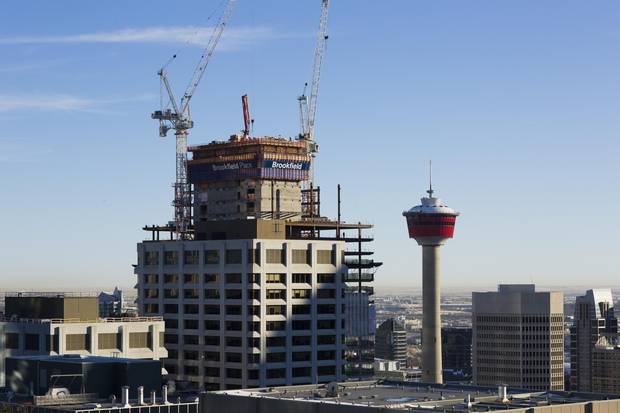The price of a barrel of oil was down again and the weather crisp on the morning of Sept. 21, as Jeff Janzen drove through Calgary traffic to his job in one of the gleaming downtown towers where most of the executives in Canada's oil industry work.
He typically drives with the radio off, enjoying a few minutes of quiet and avoiding another morning of grim news. More layoffs were coming. By late September, tens of thousands of jobs had already been lost across Alberta's economy as the price of oil had fallen by half from the nearly $100 a barrel it had been at one year earlier.
Mr. Janzen, 38, was vice-president of corporate development for Steppe Resources Inc., where he had headed the company's growth strategy for three years, working with bankers and looking for companies to acquire. Soon after walking in that morning, he was called into the CEO's office, handed a letter, thanked for his service – and told to leave. "I wasn't overly surprised," he says, "but it was pretty abrupt."
Mr. Janzen headed home and turned off his alarm clock that night. For the first time in a long time, the father of two could sleep in. He had joined the nearly 40,000 Albertans, according to the Canadian Association of Petroleum Producers, who lost their jobs in the province's energy sector last year.
Four months later, Mr. Janzen remains cautiously optimistic. "I don't think it's at a panic level yet … It's tough, but people are looking at it longer term – it's got to come back eventually, right?"
It certainly should come back – but there are growing signs that the recovery will not be nearly as rapid as Albertans had been hoping. Canada's oil-producing powerhouse is known for boom-and-bust cycles, yet its fortunes have soured considerably since that morning in late September. Hovering around $30 (U.S.) a barrel, oil has fallen to a 13-year low, and the Alberta economy is expected to contract in 2016 for the second year running, according to provincially owned ATB Financial.
The last time that happened was 1982-83, when the province weathered a recession that left scar tissue. The eighties are still spoken about in hushed tones, a time synonymous with abandoned dreams.
The impact of the current collapse has been dramatic, but only now, in the first few weeks of 2016, has it become clear to many Albertans that the protracted pain is back. As oil prices continue to fall and once-generous wages decline, the image of Alberta as a place of boundless opportunity and optimism has faded. Some now worry that Canada's economic engine hasn't just stalled, but may never again run the way it once did.
According to its trade association, 100,000 workers directly and indirectly tied to the oil-and-gas sector lost their jobs last year. Rig operators and oil-well drillers, the core of the blue-collar workforce that fuels Alberta's energy sector, have sustained a disproportionate share of the pain.
In fact, the ranks of the unemployed are approaching the high hit during the worst month of the Great Recession, and ATB Financial expects the unemployment rate to reach 8 per cent – the highest in more than 20 years. It is now 7 per cent, up from 4.7 per cent a year ago.
In the wake of those numbers (and despite an uptick in oil prices late this week) the optimism that once helped droves of unemployed Albertans like Mr. Janzen cling to the hope of rapid recovery has dimmed.
"I think most people expected this downturn to be shorter than it will be," says Jeff Callaway, a senior investment adviser with Canaccord Genuity in Calgary, and also president of the Wildrose Party, which is currently in opposition in the Alberta Legislature. "In the summer, we saw oil prices start to pick up, and people got a sense of false security. They figured that they could take their severance and work on the house for a few weeks. But then the prices rolled over and continued to fall. There has just been a series of body blows to the industry since then."
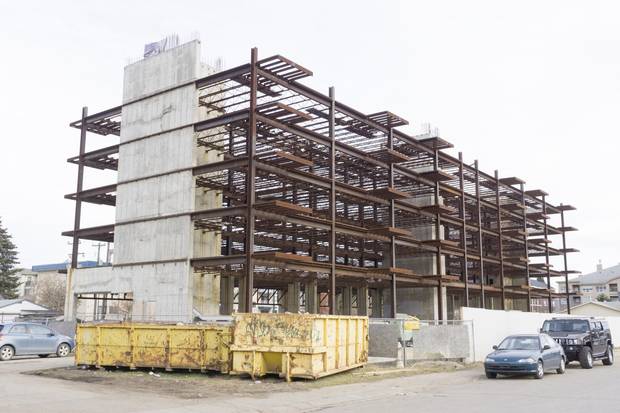
A condo under construction sits vacant in downtown Fort McMurray. Business is slow.
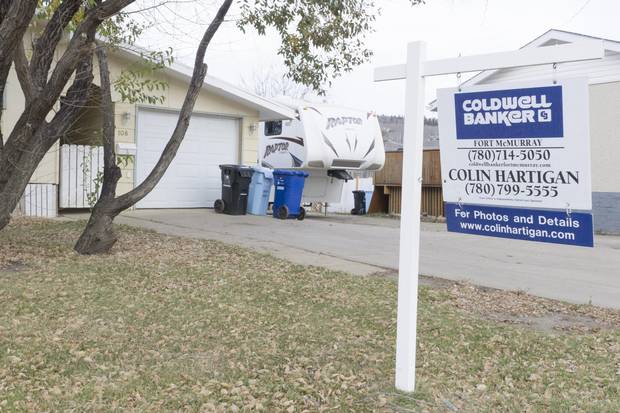
A home for sale in downtown Fort McMurray. No long ago, housing was at a premium.
SLOWDOWN IN THE SANDS
The impact hasn't been even across the province. The capital region continues to hum, aided by a New Democratic Party government that has ruled out mass cuts to the civil service. But Calgary and Northern Alberta have felt the pain, in spades. And business has slowed to a crawl in the capital of the oil sands.
While production around Fort McMurray is expected to increase this year, many projects can now operate with fewer workers, and the frantic pace of activity has largely fallen away. Businesses across the city, from car washes to barbershops, report reduced traffic. One of the last glimpses of the old Fort McMurray is in the parking lots around Tim Hortons outlets, where long lines of trucks still idle around the clock to get fresh coffee.
After a decade of constant flying back and forth from his native Nova Scotia, Brian Pettipas settled in Fort McMurray four years ago, and bought a house. But work in the oil-services industry has all but dried up. Drilling for new wells is expected to hit its lowest level in decades this year, and the percentage of time each drill rig is busy is expected to be the lowest since records began being kept in 1977.
The Bank of Canada expects energy companies to cut spending by 25 per cent this year, after slashing investment levels by 40 per cent in 2015. As oil-and-gas producers look to reduce costs, they've cut back on many of the perks that workers like Mr. Pettipas, a heavy-equipment operator who had run a dredge pump at a Suncor tailings pond until he was laid off last fall, once needed to break even.
On Jan. 15, his union posted 140 jobs for local people (part of a growing trend of hiring locally), but Mr. Pettipas says the work, while welcome, may not be enough: "They're 40-hour jobs, which would pay your bills in any other city, but you make your money on your overtime in Fort McMurray."
Reflecting the drop in worker travel, traffic at Fort McMurray's new $250-million airport has also been falling off, with passenger traffic down 16 per cent last year. Charter flights commissioned to bring in oil workers fell by 50 per cent.
The number of regular flights has also started to decline, with service cancelled to Red Deer, Denver and Mexico. WestJet announced this week that flights to Kelowna, B.C., scheduled five times a week, will be suspended in February.
"I've been around for drops before, but this one is just a little tougher and longer," says Mr. Pettipas, who grew up in a small town outside Halifax. "There will be a boom again, I just need to ride it out."
He now has a message for friends back East: "Don't come. It has to go up, but not now."
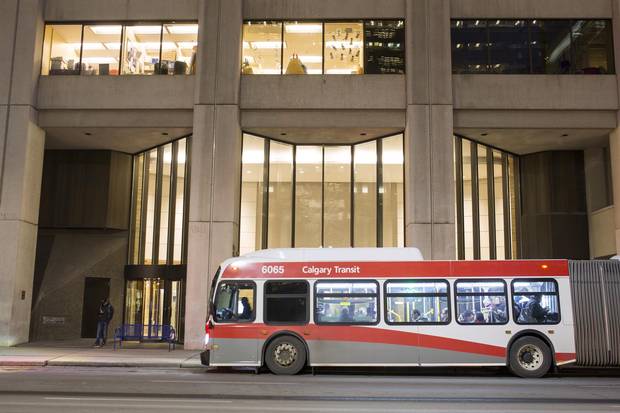
A bus collects workers for the ride home from Calgary’s financial district this week. There is no shortage of empty seats.
FROM INFLUX TO EXODUS
And the influx has slowed. Last year, before the full impact of the drop in oil prices began to bite, Calgary was still the fastest-growing city in the country, followed closely by Edmonton (which surpassed Ottawa-Gatineau as Canada's fifth-largest metropolitan area in 2013).
After years of heady growth, both Alberta cities now have overloaded transit systems, crowded classrooms, and hospitals struggling to provide proper patient care. The median age in the province in 2011 was 36.5, compared with the national median of 40.6. As a result, more Albertans are now in their child-bearing years. To meet educational demand, the government is currently building or expanding more than 230 schools. Indeed, despite hard economic times, although schools were expecting a 1.5-per-cent increase in enrolment in September, early estimates indicate that the increase was more than 2.5 per cent.
In tandem with the economic decline, the province has witnessed several other unwelcome developments:
- The suicide rate rose 30 per cent in the first half of 2015.
- Police chiefs have warned that nearly all categories of crime are climbing.
- The abuse of fentanyl, a potentially deadly and once little-known painkiller, has surged. In the first nine months of last year, 213 Albertans died from fentanyl overdoses, almost double the number of a year earlier.
- By the end of September, insolvencies across the province were up 25 per cent from a year earlier.
In fact, the great Alberta influx, which saw droves of Canadians make their way to the province in search of opportunity, may be thrown into reverse. According to the Bank of Canada's latest Monetary Policy Report, net interprovincial migration to Alberta in the third quarter of 2015 was at its lowest level since 2010.
Kevin Phone, the Calgary-based vice-president of Premiere Van Lines, says he now has about seven trucks moving people out of Alberta for each truck bringing people in. According to Mr. Phone, in the past, drivers transported belongings to Alberta from the East Coast – and then found themselves waiting weeks for a load full enough to warrant the trip back. Not any more.
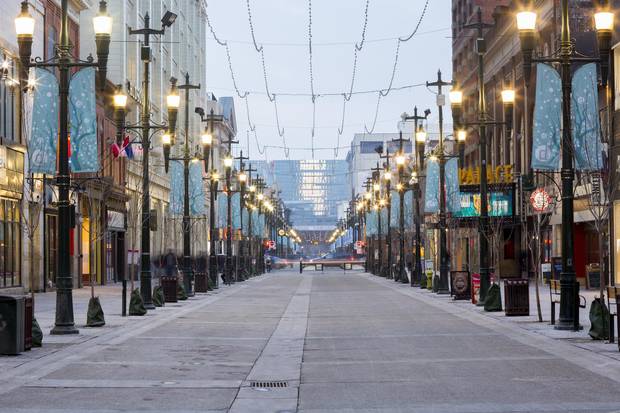
It’s quitting time, yet a major pedestrian walkway in Calgary is notably devoid of pedestrians one day this week.
AT PEAK TIMES, EMPTY TABLES
In the wake of such drastic change, the very face of downtown Calgary has begun to change. Rents are down nearly 20 per cent, according to rental websites, a remarkable decline from last January. Restaurants that once required reservations for business lunches now have open tables at peak times. And the frenzy of activity on the Plus-15 system of pedways that connects the downtown's buildings, where men and women in tailored clothes hustle between offices, is noticeably quieter.
"There's a real feeling of tumbleweeds," says Rob McMorris, who for four years has been a freelance photographer in downtown Calgary. Last fall, as companies downsized and moved to smaller offices, or emptied entire floors, Mr. McMorris – whose photos are used by real-estate services for advertising – grabbed his camera and equipment as often as five times a week to take shots of newly vacated spaces.
"What's weird here is just the vast amount of it. Every week, there was a new sublease, a new vacancy," he says. "In the last 12 months, it has been crazy."
The vacancy rate downtown now stands at more than 18 per cent – the highest inventory of empty space ever recorded here by Colliers International. During the last downturn, following the Great Recession, the commercial real-estate vacancy rate peaked at 15.2 per cent.
And while most office floors are cleaned out before he gets to them, Mr. McMorris sees the traces of the people who once worked in them. "I took photos of two floors that had been a local energy company, and everything was still there," he says. "The kitchen still had the coffee mugs and stacks of single-serving K-cups everywhere. I thought, 'Wow. They just got the call and did not come in.'"
Also falling are Calgary's outrageously high downtown parking rates, once considered second only to New York in North America. As a concession to the economy, the Calgary Parking Authority has frozen curbside rates for 2016.
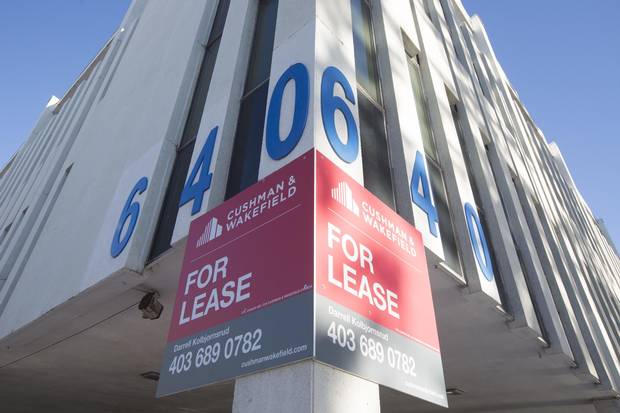
Building for lease in Calgary: A year ago unemployment was 4.7 per cent. It may soon be double that.
WHEN THE SEVERANCE RUNS OUT
For those who remain, work is increasingly hard to find.
Craig Fryzuk, who works as a bankruptcy trustee and senior vice-president with personal-services giant BDO, has had to expand his office to deal with the increase in bankruptcy filings. He recently posted a job for an administrative assistant – and received 421 resumés. "Normally," he says, "30 to 60 would be a large amount."
Many people approached his office for advice after the first round of layoffs. Six months later, as severance packages began to run out, the first flood of bankruptcy filings came in. It's indicative of the difficulties faced by a family with a $536,990 house – the average selling price for a detached home in Calgary last year – and (often) two cars, and kids.
Along with questions that come his way about renting out spaces, downsizing into a smaller home, or shedding assets, he's also had to deal with the fallout from divorces, and to be on the watch for more cases of spousal abuse and aggressive behaviour.
"For a while, I kept hearing from people that they only needed help in the short term and that they'd be hired back after the summer. It was very optimistic, that's how Albertans are," Mr. Fryzuk says.
But, he adds, "when December came around, people told us, 'Yeah, I don't anticipate being back at work until this thing turns around.' They're looking for anything they can get their hands on."
BOOM TIME FOR THE BAILIFF
When mortgage payments are missed and banks foreclose, people like John Shortridge appear on the scene. The owner of Allied Shortridge Civil Enforcement says he is already seeing a 60-per-cent rise in demand for bailiffs – and is looking to hire. "We're the people at the end of the system,' he notes, "where everything has failed."
It can take six months for an eviction process to work its way from first notice to a knock at the door. "Someone who has fallen behind can't blame the economy – it's an abstract thing," Mr. Shortridge says. "But when the bailiff shows up, they can put a face on it – we get yelled at. A bailiff needs to have broad shoulders."
Yelled at or not, he adds, "If you don't move within two days, when we come back, we pack everything up and put it in storage. You need to pay all the costs … The worst is that you lose all those baby pictures, which have no value for anyone else, but are priceless for you. It's heartbreaking,"
He reads the business pages closely, knowing that a further decline in oil will increase demand for his services.
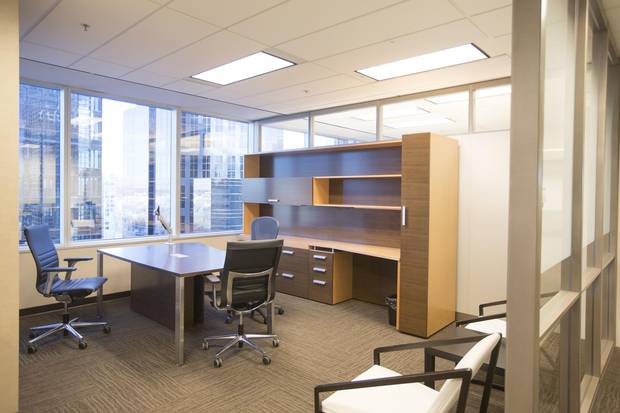
An empty desk at an oil and gas company in downtown Calgary that, with recent layoffs, has had to consolidate its 11 floors into just five.
VISIONS OF A NEW NORMAL
Until being laid off on Nov. 16 as part of a five-per-cent cut to the workforce at Enbridge, Greg Nichols was director of customer service at the company, running scheduling activities for the pipeline giant's North American crude-oil system. He calls his nearly five years at the company "fantastic," and seems to bear no ill will against it. In fact, he sheepishly admits, moves he recommended may have led to what happened to him.
Having paid down his debt, the Saskatchewan-born Mr. Nichols is in relatively good shape. He is treating his time off as an opportunity: reflecting on his career, looking for a new challenge, and extending his gaze beyond Canada.
Still, he may have to recalibrate his expectations. "In the last couple of days," he says, "I was talking with an executive recruiter based in the U.K. and he asked me what my base salary was – and then added, 'keeping in mind that this is Calgary we're talking about, and I'll rebase your salary in reality.' That may not be exactly what he said, but he was saying that everyone in this city is going to need to shift their expectation of total compensation."
With the outsized wages of the oil patch leading to wage inflation across the province, the median income for an Alberta family was $97,390 in 2013 – far above the national median of $76,550. The gap was even more pronounced in Calgary, where the figure tipped over $101,000.
Thanks to the late Ralph Klein, Albertans also got to keep more of their earnings than did other Canadians. With no sales tax, and a flat 10-per-cent provincial tax on incomes, Mr. Klein trumpeted the "Albertan Advantage" while premier from 1992 to 2006.
But those low tax rates are now a thing of the past for many Albertans. After her election as premier last year, the NDP's Rachel Notley hiked the income-tax rate for anyone making more than $125,000. Indeed, starting this year, the tax on incomes over $300,000 rises sharply – from 10 per cent to 15.
Five things to know about the Alberta NDP’s budget plan
0:32
At the same time, the regulatory burden on business has been growing. Calgary remains a hub for entrepreneurs, but Alberta has slipped behind Saskatchewan in most ease-of-business rankings. "The high price of oil helped us cover up a lot of inefficiencies across the board," says Canaccord Genuity's Mr. Callaway.
"It now takes three years, or longer, to get a small oil-sands project approved in Alberta. Across the border in Saskatchewan, it takes six months. There are burdens here in Alberta where we are getting in our own way."
The economy has also made life difficult for corporate recruiters. Jessica Young could once plan more than six months in advance, working with a good sense of who would be hiring and when. But this year, says the Calgary-based representative of executive-search firm Pekarsky & Co., "it seems like it'll be harder to see … down the line."
Laid-off executives and managers come to Ms. Young looking for help, but the economic contraction is bad for her business. "The stress of this economy has seen people's emotional reactions creep in," she says. "They tell us about chasing leads for months and nothing coming up. Some people haven't been out of the workforce for 20 years."
At the same time, she says, hard times are laying bare the shortcomings of some executives who were hired when profits were high, and standards sometimes low. "It's easy to see levels of competence when the tide is going out," she says.
In fact, Ms. Young has recently shifted her focus away from the oil-and-gas industry, to event hiring and not-for-profits. In the spring, she will be leaving her native province altogether, to open her company's new office in Toronto. "I think people are starting to see through the veneer of the Alberta Advantage," she says. "They're seeing that things might not turn back again; they aren't planning on an upswing any more."

Some floors in Calgary’s office building are dark just after 5 p.m.
'LIKE BEING HIT BY A BLUNT OBJECT'
How low will Alberta go? "It looks like the 1980s all over again," says Mr. Callaway. "I don't want to be Dr. Doom and Gloom, but it looks likely that we're facing more pain."
Between 1981 and 1983, as the province faced high interest rates, a collapsing oil price and the National Energy Program brought in by the federal Liberals, its gross domestic product contracted by 9.8 per cent. Bankruptcies increased by 50 per cent in 1983 over 1982, which was itself a bad year. Unemployment rose to nearly 12 per cent, from 4.5 per cent; housing markets collapsed. Mr. Klein, then the mayor of Calgary, drove a front-end loader through a plywood wall of "negativity" in a campaign to fight recessionary gloom.
"This recession will be like being hit by a blunt object – it … won't be as painful, but it will last for much longer," says Todd Hirsch, chief economist for ATB Financial. "This will probably be the longest downturn since the 1980s."
While he says that there are many similarities between this recession and the 1980s, there is one very different variable: interest rates. "Mortgage rates in the mid-eighties were 15 to 18 per cent, so when you lost your job and were without an income for a month or two, you were almost certainly going to default on your mortgage." Rates today are around 4 per cent, and many more households now have two income-earners, which helps to mitigate the impact of a layoff.
Mr. Hirsch predicts that Alberta has "not reached bottom yet." Following last year's one-per-cent contraction, he now expects that the economy will shrink by 0.5 per cent in 2016 – a prediction he says has changed "in a very substantial way" since the start of the Christmas break.
He expects another round of layoffs in the spring, estimates that unemployment will reach 8 per cent by year's end, and thinks that oil has fallen so far below the break-even point for many energy projects that any recovery will be gradual. "The bottom will come over the next six months, with some gradual improvement at the end of 2016. The light at the end of the tunnel is another eight to 12 months off. It'll be a return to where we were last October." Adds Mr. Hirsch: "The industry will be gasping for air, but at least they can gasp."
With Premier Notley speaking about the need to diversify Alberta's economy to reduce the impact of future oil crashes, Mr. Hirsch says some diversification will occur organically. But that, he says, will also require a change in expectations. "We might have to get rid of the idea that we'll always have three-per-cent unemployment and five-per-cent growth – nearly Chinese levels of growth – here."
One upside, he adds: "We might be more tempered, and healthier, in the long run."
'SOMETHING WILL GIVE'
Some Albertans may look for opportunities beyond oil and gas, but the energy sector is what many know best. After losing his job at Steppe Resources, Jeff Janzen met up with a geologist laid off the same day. "We always got along with each other, respected each other, so we decided to start something up," he says. "We've been working to secure funding and start purchasing some assets."
Along with two other partners, they've founded Islander Oil and Gas. With the prices of energy assets depressed, he say it's a good time to buy. While some investors are waiting on the sidelines, holding out for the economy to hit bottom, Mr. Janzen is optimistic that oil will bounce back, and is looking for assets that will be worth a lot when it does.
"Do I want to start an oil-and-gas business in Alberta right now? Honestly, it would be a lot easier in Saskatchewan or Manitoba. They're more business-friendly," he says. But with two young children, he isn't ready to move. "I'm pretty optimistic," he adds, "that something will give."
Justin Giovannetti is a reporter in The Globe and Mail's Edmonton bureau.
THE GLOBE IN ALBERTA
Bitumount: Looking back at where Alberta’s oil-sands production started
6:39
